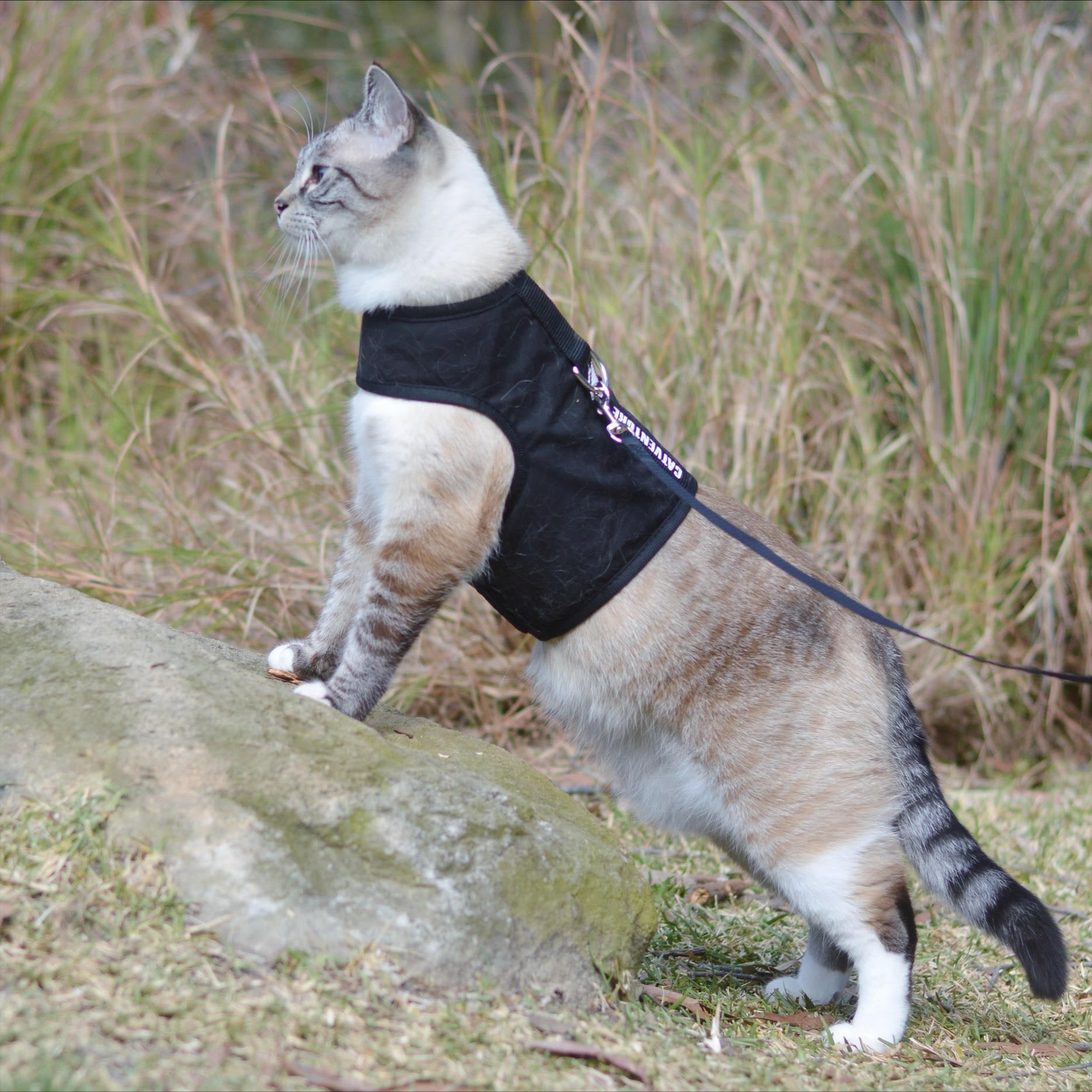Welcome to the fascinating world of clicker training for cats! At Cat Harness Australia, we understand the unique bond between cats and their owners. That's why we're excited to introduce you to a training method that not only strengthens this bond but also enhances your cat's mental stimulation and physical activity. Clicker training, a popular technique in the dog training world, is equally effective for our feline friends. Coupled with our specially designed Catventure harness, clicker training opens up a new realm of possibilities for cat owners, from teaching basic commands to advanced tricks and effective harness training. Whether you’re a seasoned cat owner or new to the world of feline companionship, this guide will help you understand the basics of clicker training and how to apply them to enrich both your life and your cat’s.
What is Clicker Training?
Clicker training is a positive reinforcement-based training method that has gained popularity among pet trainers and owners alike. Originating from the scientific principles of operant conditioning, it involves using a small handheld device, the clicker, which makes a distinct 'click' sound. This sound becomes a signal to the animal that they have performed a desired behaviour and a reward is forthcoming.
The effectiveness of clicker training lies in its simplicity and clarity. The distinct sound of the clicker cuts through other environmental noises, providing a consistent and clear signal to your cat. It leverages the power of classical conditioning, a learning process made famous by Ivan Pavlov in the early 20th century. In clicker training, the click sound is associated with positive rewards, usually treats, creating a powerful and encouraging learning tool for your cat.
One of the greatest benefits of clicker training is its ability to enhance communication between you and your cat. It provides immediate feedback, helping your cat understand exactly which behaviour is being rewarded. This clarity accelerates learning and strengthens the bond between you and your pet. It’s also an incredibly versatile method, suitable for teaching a wide range of behaviours, from basic obedience to complex tricks. For cat owners, clicker training offers an opportunity to engage with their cats in a fun and rewarding way, enhancing their pet's mental stimulation and reducing behavioural problems.
Continue reading for tips on how to get started with clicker training and how it can be applied to various aspects of cat care, including harness training with our Catventure harness.
Getting Started with Clicker Training
Embarking on your clicker training journey begins with understanding the basics and preparing yourself and your cat for a successful experience. First, select a clicker. These small devices are inexpensive and available at most pet stores. Choose one with a sound that is distinct but not too loud, as cats have sensitive hearing.
The foundational principles of clicker training are timing, consistency, and positive reinforcement. Timing is crucial; the click must occur immediately after the desired behaviour to create a clear association. Consistency in the use of the clicker and rewards reinforces this learning. Positive reinforcement, typically in the form of your cat's favuorite treats, motivates and encourages your cat to repeat the behaviour.
Introducing Your Cat to the Clicker
Introducing your cat to the clicker is a gradual process. Start by simply clicking and immediately offering a treat. This step allows your cat to associate the click sound with positive rewards. Practice this for a few minutes each day until you notice your cat responding to the clicker's sound with anticipation.
At this stage, patience is key. Each cat learns at their own pace, and it’s important to progress according to your cat’s comfort and interest levels. Avoid overtraining or pushing your cat too hard, as this can lead to frustration and a lack of interest. Short, enjoyable training sessions are more effective than longer, more demanding ones.
Clicker Training for Basic Commands
Once your cat is familiar with the clicker, you can begin teaching basic commands. Start with simple behaviours like 'sit' or 'touch' (where your cat touches their nose to your hand or an object). For example, when your cat naturally sits, click and immediately give a treat. Repeat this process, gradually introducing a verbal cue like "sit" before the action.
Breaking Down Commands into Manageable Steps
The key to success with basic commands is to break them down into small, manageable steps. If you’re teaching your cat to sit, you might first reward them for looking at you, then for lowering their back end, and finally for sitting completely. This step-by-step approach helps your cat understand what you’re asking for.
Remember to always end on a positive note. If your cat is struggling with a new command, revert to something they know and end with success. This maintains their confidence and enjoyment in the training process.
Positive reinforcement is your most powerful tool. Cats are more likely to repeat behaviors that result in good things for them. Treats are a common reward, but you can also use praise, petting, or play, depending on what your cat enjoys most.
Advanced Clicker Training: Tricks and Fun Activities
After mastering basic commands, you can venture into more advanced tricks and activities, making training sessions an enjoyable and stimulating experience for your cat. This stage not only enhances your cat's cognitive abilities but also strengthens your bond.
Teaching Advanced Tricks
Start with simple tricks like 'high five' or 'roll over'. For a high five, hold a treat in your closed hand and encourage your cat to paw at your hand. Once they make contact, click and reward. Gradually, raise your hand higher and start using the verbal cue 'high five'. For rolling over, lure your cat with a treat to turn on their side and then gently roll over. Click and reward each small step towards the full roll.
Using Props for Agility Training
Incorporating props can add variety and challenge to your training sessions. Use tunnels, jumps, or homemade obstacle courses to create an agility training setup. Guide your cat through these obstacles using treats and click to mark successful navigation.
Remember, the goal is to keep training fun and engaging. Pay attention to your cat's mood and interest level, and vary the activities to keep them stimulated. Celebrating small achievements with lots of praise and treats will make these training sessions a highlight for your cat.
Harness Training with Clicker Training
Harness training is a fantastic way to safely explore the outdoors with your cat. Combining clicker training with our Catventure harness can significantly ease this process. Start by familiarising your cat with the harness. Place it near their favourite spots and allow them to investigate it on their own terms. Once they seem comfortable, drape it over them without fastening it, clicking and rewarding any calm behaviour.
Introducing the Harness
Gradually progress to fastening the harness for short periods while indoors. Use the clicker to mark calm behaviour and reward generously. The key is to associate the harness with positive experiences. Practice walking your cat around the house on the harness, using the clicker to reinforce and reward their cooperation.
As your cat becomes more comfortable, introduce the leash. Let them drag it around to get used to the weight and feel. Always supervise these sessions to ensure safety. Once they’re used to the leash, start guiding them gently, clicking and rewarding positive responses to your direction.
First Outdoor Adventures
When transitioning outdoors, choose a quiet, safe space for your cat’s first outdoor adventure. Keep initial outings short, using the clicker to reinforce and reward their exploration and calm behaviour. Gradually increase the duration and complexity of your outings as your cat becomes more confident.
Harness training with clicker training is not just about walking your cat; it’s about creating enjoyable and stress-free outdoor experiences. It’s a gradual process that requires patience and consistency, but the rewards of exploring the world together are immeasurable.
Clicker Training for Recall and Other Practical Skills
Training your cat to come when called (recall) is not only impressive but also a crucial safety skill. Start in a quiet environment without distractions. Call your cat's name followed by a cue like "come". When they move towards you, even slightly, immediately click and reward. Gradually increase the distance and add distractions as they improve.
Practical Household Behaviors
In addition to recall, clicker training can be effectively used for practical household behaviours like litter training, scratching appropriate items, or calmly accepting grooming and vet visits. For litter training, click and reward every time your cat uses the litter box. For encouraging scratching on appropriate items, click and reward when they use a scratching post instead of furniture.
Addressing Behavioral Issues
Behavioural issues like excessive meowing, aggression, or anxiety can also be addressed with clicker training by redirecting and rewarding alternative, positive behaviours. It's about understanding the underlying cause of these behaviours and using the clicker to reinforce more appropriate responses.
Advanced Tips and Troubleshooting
While clicker training is generally effective, it’s not without its challenges. Cats may lose interest, become distracted, or not respond as expected. If your cat seems disinterested, reassess the value of the reward – it might not be enticing enough. Ensure training sessions are short and fun to keep their interest piqued.
Addressing Sensitivity to the Clicker Sound
If your cat is scared of the clicker sound, muffle it by wrapping it in a cloth or use a softer-sounding alternative like a pen click. Always observe your cat's body language and adjust your approach accordingly.
Tailoring Rewards
Some cats may be more food-motivated, while others respond better to play or affection. Tailoring the reward to your cat’s preference is crucial for effective training.
Remember, each cat is unique and what works for one may not work for another. Patience, observation, and adaptation are key. Don’t hesitate to seek advice from a professional cat trainer if you encounter persistent challenges. Our recommendation is Melina from Pet Nurture.
Why Volume Adjustability Matters On A Clicker Trainer
Cats vary in their sensitivity to sound. The majority of standard clicker trainers have a volume that might startle a cat that is new to clicker training. This may impact the effectiveness of the clicker.
Cat Harness Australia offers Adjustable Multi Clicker trainers. This is useful for training cats of various age groups, especially those who are older and more sensitive to sound.
Conclusion
Clicker training offers a unique and effective way to communicate with your cat, enriching both their life and yours. By using positive reinforcement, you can teach your cat a variety of behaviours, from basic commands to advanced tricks and practical skills. Combining clicker training with our Catventure harness can make harness training a seamless and enjoyable experience. At Cat Harness Australia, we believe in the power of fun, discipline, and the deep bond between cats and their owners. Happy training!












